Managing Urethral Obstructions in the Dog
What is a Urethral Obstruction?
Bladder stones becoming lodged in the urethra are the most common cause of obstruction. This occurs mostly in the male dog because they have a long urethra which narrows distally.
What is a Urethrotomy?
A urethrotomy is a surgical procedure that entails entering the urethra at the level of the obstruction to remove it. It is more difficult to remove stones through a urethrotomy than a cystotomy. The complication rate tends to also be higher with the urethrotomy. This is why it is better to retropulse the stones back into the bladder and remove them from there.
Situational Awareness
Retropulsing stones from the urethra is another LIFE SAVING procedure every veterinarian will need to perform someday.
If the obstruction is ACUTE, the dog will quickly become uncomfortable, anxious, and unable to pass urine despite frequent attempts. This is an emergency situation; the onset of azotemia is an indicator of severity. In acute cases retropulsion should be successful 100% of the time. Lack of success is usually due to inappropriate catheter selection and flushing technique. Follow the steps described here and ensure that your team (yes, you need a team for this) understands their role.
A CHRONIC obstruction usually results from a smaller stone being lodged in the urethra, typically at the level of or within the os penis. The stone is too large to be passed during micturition but is not so large that it fully obstructs the flow of urine. These patients present with a history of taking a long time to urinate, often with a very narrow stream. They may also display pollakiuria, dysuria and hematuria. These are by far the more difficult stones to dislodge and retropulse back into the bladder. Failure to successfully retropulse a stone from the urethra is more likely to occur with this patient.
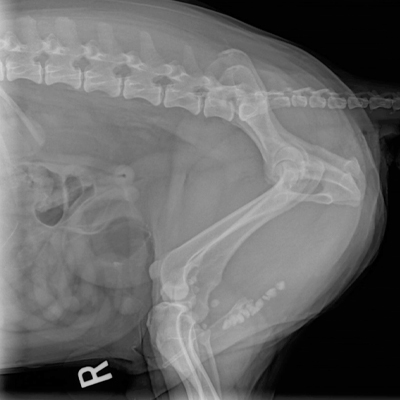
$250
Get ready to retropulse:
All the information you need.
Fully narrated surgical videos.
In depth guide and more.
Pre-procedural Considerations:
- Stabilize the patient
- palpate to assess the bladder size
- get blood work to assess the kidneys and electrolytes
- establish an IV access
- Empty the bladder
- use a small gauge catheter to get past the stone and into the bladder.
- If not possible – how full/turgid is the bladder?
- if not turgid: proceed cautiously with retropulsion
- If turgid: perform a cystocentesis first
- Good radiographs of the Lower Urinary Tract
What the client needs to know:
- Retropulsions are usually successful with acute obstructions when properly performed.
- Once the stone is dislodged from the urethra, the patient can be taken to surgery so the stones can be removed from the bladder, or, if necessary, the patient can be stabilized with fluids for several hours and have the surgery the next morning or later that day, once stable.
- Retropulsion of chronic uroliths, although often successful, are more likely to require a urethrotomy than the acute ones. A cystotomy may still be necessary after a urethrotomy, depending on the number and size of stones that are in the bladder.
- Appropriate dietary management will be necessary
Key points for a successful retropulsion (and watch the video!):

- Figure 1
Place a large red rubber or stiffer PVC catheter up against the urolith. Occlude the penile orifice around the catheter.
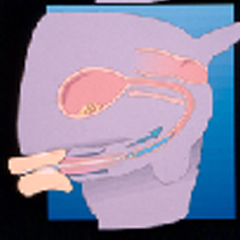
- Figure 2
Quickly push a BOLUS of warm saline through the catheter. Often this is sufficient to dislodge the stones. If the stones have moved but have not completely cleared the urethra (as per radiographs), simply repeat these 2 steps. Check the size of the bladder frequently through out the procedure.
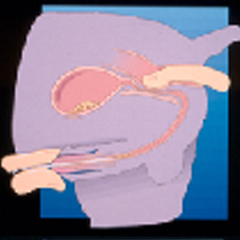
- Figure 3
If steps 1&2 did not succeed in dislodging the stones then have an assistant occlude the pelvic urethra with a finger.
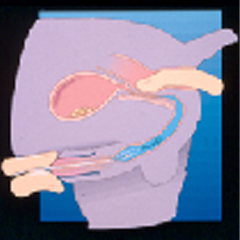
- Figure 4
Then repeat steps 1&2; the bolus of warm saline against the occluded pelvic urethra will serve to expand the penile urethra.
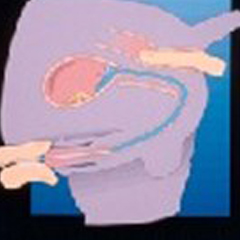
- Figure 5
As the warm saline is bolused into the urethra, the assistant will lift their finger off the floor of the pelvis, allowing the saline (and uroliths) to flow into the bladder. The occlusion/ unocclusion of the pelvic urethra is done intermittently while the saline is being bolused. Check the size of the bladder frequently through out the procedure.
Get ready to retropulse:
Instrumentation:
- Assemble your team
- Sedation and pain medications (valium or medetomidine and narcotic)
- Assemble your equipment:
- Large PVC or red rubber catheter
- Saline for flushing (preferably warm)
- Sterile lubricant
- Set up in radiology
- Post-obstruction actions:
- Proceed with a cystotomy now or at a more convenient time or once the patient is better stabilized for a general anesthesia.
- Leave a soft catheter (red rubber or other but not the PVC) within the urethra until the cystotomy can be performed.
Post-op expectations:
- Urine leakage is a rare issue in these patients.
- Healing time is relatively rapid and mostly attributable to the abdominal incision.
- The pet may have hematuria/pollakiruia for 0-3 days after surgery.
What you get when you register:
- Detailed description of each step and why they will work if applied properly, and fail if not.
- Further drug considerations
- How to manage the more difficult/tenacious obstructions (i.e. plans B, C and D).
- How to perform a urethrotomy safely, minimizing complications; what to expect post-op.

Q & A
How long can dogs live with a urethral obstruction?
If the urethra is fully obstructed then 1-3 days at best, but what a horrible 1-3 days that will be for the dog!
Workshop Content
Workshops & Courses
Blog
 The Secret to having the Bandage stay Above the StifleJuly 3, 2024 - 1:44 pm
The Secret to having the Bandage stay Above the StifleJuly 3, 2024 - 1:44 pm Common Mistakes made by Veterinarians when doing the Drawer TestJune 26, 2024 - 9:22 am
Common Mistakes made by Veterinarians when doing the Drawer TestJune 26, 2024 - 9:22 am Burying the end knot in a continuous subcutaneous suture patternJune 19, 2024 - 7:35 pm
Burying the end knot in a continuous subcutaneous suture patternJune 19, 2024 - 7:35 pm Creating Donuts for your BandagesJune 12, 2024 - 3:15 pm
Creating Donuts for your BandagesJune 12, 2024 - 3:15 pm The Knotless Suture PatternJune 5, 2024 - 2:45 pm
The Knotless Suture PatternJune 5, 2024 - 2:45 pm

